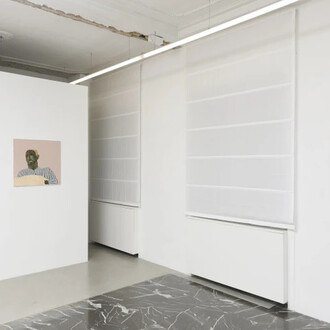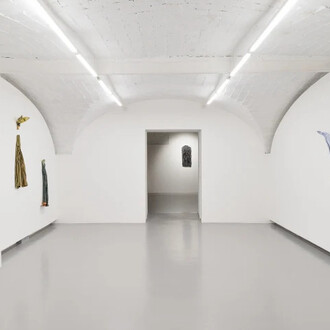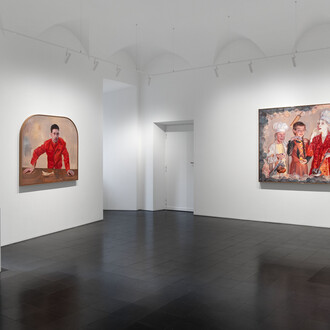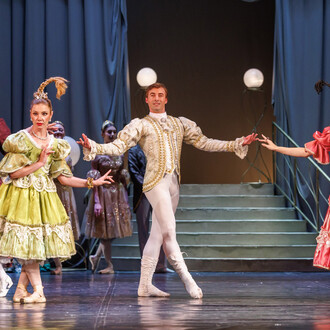Freedom of Movement is a revisiting of the 1960 Olympic marathon in Rome, when the first black African runner won the gold medal.
With this work, we examine the complexity of ideological, political and architectural implications of the image of Abebe Bikila running from Rome ‘60 to this day.
The artwork consists of 3 simultaneous projections. On the first screen, an African runner inscribes once again episodes and architectural scenarios of the historical marathon into the streets of Rome. On the second, a choir of African refugee teenagers moves across the spaces of the “Colosseo Quadrato” at EUR and step on its roof to perform a song about their own identity and that of the country now hosting them. On the third screen, sequences of a contemporary night run are superimposed with footage of the 1960’s marathon and intertwined with archive material of the construction of the EUR and Foro Italico. The narrative aims at linking the stories of the 1960’s marathon, the current migration crisis and the silent language of Rome’s controversial modernist architecture.
Freedom of Movement by Nina Fischer (1965) and Maroan el Sani (1966), coproduced by the MAXXI, is a mixture of video installation, research and photography, and enables the artists to keep investigating the most extreme aspects of the relationship between architectural and human space. The project was commissioned by the museum, and it perfectly fits within the MAXXI architecture Collection, which is not new to investigating the boundaries of architectural styles and their links with the visual forms of artistic expression.
The idea stemmed from the wish of the museum to investigate the relationship between the history of the city, that of sports buildings and architectural styles. The keen eye of the artists has enabled Freedom of Movement to become a deep, original insight into Rome, its architecture and its inhabitants. The video, which was shot in several monumental places of the city, deals with the pressing matter of great migration flows and highlights the role sport plays in peace and integration processes, which makes it paramount for the social innovation, civil progress and cultural development of communities.
While cooperating with “new resident” communities, Fischer & el Sani dug deep into the archives and brought to light the“barefooted”pictures of Abebe Bikila, the first African athlete to win the Olympic gold medal. This way, they show the unconscious links between the pictures of Rome in the 1960s and those of today’s migrants and refugees, who also run barefooted among the – mainly modern – monuments of the city. They claim their right to“freedom of movement” in sports and in the possibility to find space in another country, starting living again and expressing themselves through sport and culture. The wonderful treble voice chorus of the Emmaus Christian School of Maenza moves through the spaces of the Palazzo della Civiltà Italiana, thereby giving shape to such culture, and sings a revisited version of the famous sentence carved in the façade of the building.
At the end of the production work carried out in 2016, the MAXXI dedicates a personal exhibition to the artists. Such exhibition shows a work which was realized thanks to the cooperation of several entities and institutions, such as Liberi Nantes, the Emmaus Christian School of Maenza, Fendi and Coni.
Nina Fischer & Maroan el Sani (Germany, born 1965 and 1966) are visual artists and film directors. Both live and work in Berlin. From 2007 - 2010 they were Professors of Film and Media Art at Sapporo City University, Japan. Since 2015 Nina Fischer is Professor of Experimental Film / Media Art at Universität der Künste Berlin. Fischer & el Sani’s work is a permanent pursuit of and negotiation with the transition of time. They are exploring historic traces and utopian visions of social developments, politcal culture and avant-garde art that embody such a transition. Fischer & el Sani have taken part in numerous international exhibitions, including Media City Seoul Biennale (2012, 2014), Istanbul Biennial (2007), Gwangju Biennale (1995, 2002, 2008), Sydney Bienniale (2002), and many other group events. Solo exhibitions at K21 - Kunstsammlung NRW, Düsseldorf (2015), Berlinische Galerie – Museum of Modern Art, Berlin (2012), Museum of Contemporary Art, Hiroshima (2010), Stedelijk Museum Bureau, Amsterdam (2007).
















